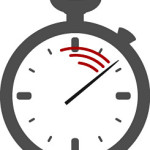All we need is big, stiff springs and big, thick rollbars to go racing, right? Only if our tracks were as flat as a pool table. Every bump or irregularity in the track upsets our cornering race car to some degree, so we need to have suspension compliancy as well as stiffness. And there is a reason why Formula One drivers need to be as fit as Olympians, a stiff suspension really wears you out! In able to increase our cornering speeds, we need as much adhesion to the track as possible through our tires. Stiffer springs allow less body roll, keeping all four tires on the track as we corner at high speeds, increasing traction with more rubber on the road. Sway bars (also known as roll bars, but correctly known as anti-sway or anti-roll bars) transfer some weight from the outside wheels of the car to the inside wheels, again increasing traction by keeping more rubber on the road. Adding negative camber to the suspension (leaning the tops of the tires inward when the car is at rest) also increases the size of the tire patch to the ground while cornering. But since every corner on the track has a different radius, different bumps, and a different surface texture, the right combination of suspension settings is an ever changing dance. There are only two ways to determine if you have the proper suspension setup on your race car: a stopwatch, and a tire pyrometer. If the setup allows you to go faster, then it’s better, period. Also a properly set up suspension will create even temperatures across the surface of the tire (measured at the inside, center, and outside of the contact patch). Steady temps across your tire will allow it to give you its maximum traction for a longer period of time. Here is an excellent article on using a tire pyrometer to help set up your suspension.
Finding the correct spring rates, sway bar diameter, and shock absorber valving is properly viewed as an art form. You can try out known setups from other racers, but until you try them out for yourself, you really won’t know if they’re any better. And what works better for one driver’s racing technique won’t necessarily work better for you. Trial and error is the only way to find out, and you must go about your experimenting in a scientific manner. You need to make just one component change or adjustment at a time, and put a stop watch and tire pyrometer to the car to find out if the change was an improvement or a detriment. And you need to keep copious notes so you can refer back to your baseline settings when you can’t create an improvement. Often a driver will come into the pits saying that the changes made the car “feel” worse, just to be told “but your times were faster”! Test, test, test, that’s the only way to find out what truly works.

Leave a Reply